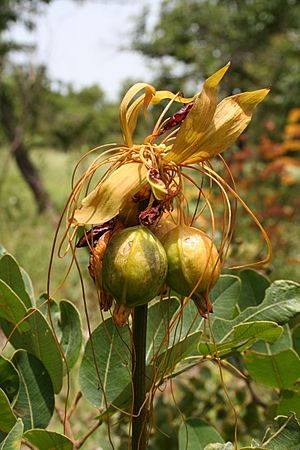Polynesian arrowroot facts for kids
Quick facts for kids Polynesian arrowroot |
|
|---|---|
 |
|
| Scientific classification | |
| Genus: |
Tacca
|
| Species: |
leontopetaloides
|
| Synonyms | |
|
|
Polynesian arrowroot (Tacca leontopetaloides) is a type of flowering plant that belongs to the yam family. It originally comes from Island Southeast Asia. Long ago, people called Austronesian peoples carried this plant with them in their canoes as they traveled across the tropical parts of the Indo-Pacific. This is why it's sometimes called a "canoe plant." Today, you can find it growing naturally in tropical Africa, South Asia, northern Australia, and Oceania. People also know it as Fiji arrowroot, East Indies arrowroot, or pia.
Contents
A Plant's Journey: History of Cultivation
Polynesian arrowroot is an old Austronesian root crop. It is related to yams. This plant first grew in Island Southeast Asia. About 5,000 years ago, Austronesian peoples began to spread it. They took it with them as they explored new lands. This included places like Micronesia, Polynesia, and Madagascar.
Scientists have found Polynesian arrowroot at Lapita sites in Palau. These findings date back 3,000 to 2,000 years ago. The plant also reached Sri Lanka, southern India, and possibly Australia. This happened through ancient trade and contact.
Why Polynesian Arrowroot Was Important
Polynesian arrowroot was a helpful food for Austronesian people. Its roots can taste bitter if not prepared correctly. Because of this, it was usually a backup crop. Main foods were often Dioscorea alata (a type of yam) and Colocasia esculenta (taro).
The plant became more important for people settling in the Pacific Islands. Food plants were harder to find there. So, Polynesian arrowroot was brought to almost all the islands where people lived. It was special because it could grow well on low islands and atolls. On these islands, it often became a main food source. On larger islands, it sometimes grew wild. People would then use it as a famine food if other crops failed.
Over many years, people in Polynesia developed different types of this plant. This was done through careful selection. The starch taken from the root could be stored for a very long time. This made it good for saving or trading. People would cook the starch in leaves to make puddings. This was similar to how starch from sago palms (Metroxylon sagu) was used. Today, modern crops are more common. So, Polynesian arrowroot is not grown as much anymore.
What Polynesian Arrowroot Looks Like
This plant has several long stems called petioles. They grow from the center of the plant. These petioles can be from 17 to 150 centimeters (about 7 to 59 inches) long. Large leaves grow on these stems. The leaves can be 30 to 70 centimeters (about 12 to 28 inches) long. They can also be up to 120 centimeters (about 47 inches) wide.
The top of the leaf has sunken veins. The underside is shiny with bold yellow veins. The flowers grow on tall stalks. They appear in greenish-purple groups with long, hanging parts called bracts. The plant often rests for part of the year. During this time, it dies down to the ground. Later, new leaves will grow from its round underground tuber. The tubers are hard and look like potatoes. They have a brown skin and a white inside.
How People Used Polynesian Arrowroot
The tubers of Polynesian arrowroot are full of starch. This made them a key food source for many Pacific Island cultures. It was especially important for people living on low islands and atolls.
Food and Cooking
Polynesian arrowroot was often made into a flour. This flour was used to make different kinds of puddings. First, the tubers were grated. Then, they were soaked in fresh water. The starch would settle at the bottom. This starch was rinsed many times to remove its bitter taste. After rinsing, it was dried. The flour was then mixed with mashed taro, breadfruit, or Pandanus fruit extract. It was also mixed with coconut cream to make puddings.
In Hawaii, a popular treat is haupia. This dessert was originally made with pia flour, coconut cream, and kō (cane sugar). Today, cornstarch has mostly replaced Polynesian arrowroot in many recipes.
Other Uses
The starch from the plant was also used to make fabrics stiffer. On some islands, the stem's bast fibres were woven into mats.
In traditional Hawaiian medicine, raw tubers were eaten to help with stomach problems. When mixed with water and red clay, the plant was used to treat diarrhea and dysentery. This mixture also helped stop internal bleeding in the stomach and colon. It was also put on wounds to stop bleeding.

